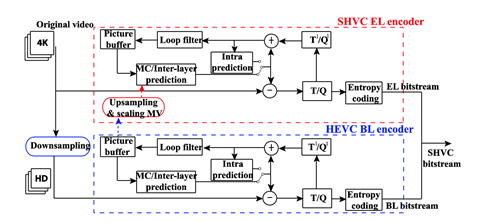ABSTRACT
Broadcast and broadband networks continue to be separate worlds in the video consumption business.
Some initiatives such as HbbTV have built a bridge between both worlds, but its application is almost limited to providing links over the broadcast channel to content providers’ applications such as Catch-up TV services.
When it comes to reality, the user is using either one network or the other.
H2B2VS is a Celtic-Plus project aiming at exploiting the potential of real hybrid networks by implementing efficient synchronization mechanisms and using new video coding standard such as High Efficiency Video Coding (HEVC).
The goal is to develop successful hybrid network solutions that enable value added services with an optimum bandwidth usage in each network and with clear commercial applications.
An example of the potential of this approach is the transmission of Ultra-HD TV by sending the main content over the broadcast channel and the required complementary information over the broadband network.
This technology can also be used to improve the life of handicapped persons: Deaf people receive through the broadband network a sign language translation of a programme sent over the broadcast channel; the TV set then displays this translation in an inset window.
One of the most important contributions of the project is developing and testing synchronization methods between two different networks that offer unequal qualities of service with significant differences in delay and jitter.
In this paper, the main technological project contributions are described, including SHVC, the scalable extension of HEVC and a special focus on the synchronization solution adopted by MPEG and DVB.
The paper also presents some of the implemented practical use cases, such as the sign language translation described above, and their performance results so as to evaluate the commercial application of this type of solution.
INTRODUCTION
Started in January 2013, H2B2VS (1) is a Eureka Celtic-Plus project. It is aiming at investigating the hybrid distribution of TV programs and services over broadcast and broadband networks.
The technology used for the contents compression is the emerging video coding standard: High Efficient Video Codec (HEVC).
Coordinated by Thomson Video Networks, the consortium is composed of 21 partners.
The project is organized around four main Work Packages (WP).
The goal of the first one is to study uses cases and business models to guarantee that the work done by the project is in line with the market’s expectations.
WP2 is dealing with the technologies to be adapted in order to allow HEVC hybrid distribution.
All these technologies are integrated in WP3 to build demonstrators which are used by WP4 in public demonstrations as a basis to disseminate project’s results throughout the industry.
One of the major outcomes of WP4 is also the contribution to the relevant standardization bodies in order to guarantee a successful commercial deployment of the technology.
MAIN TECHNOLOGICAL CHALLENGES
Among all the challenges the project had to face, two are predominant for the use cases which are described in this paper. The first one is scalable coding and the second one is synchronization.
Scalable Video Coding (SHVC)
The Scalable High efficiency Video Coding (SHVC) is the scalable extension (2) of the HEVC standard.
SHVC extension (3) was finalized in July 2014 by the ITU-T Video Coding Experts Group (VCEG) and the ISO/IEC Moving Picture Experts Group (MPEG) under a partnership known as Joint Collaborative Team on Video Coding (JCT-VC).
SHVC defines tools to provide spatial, fidelity, bit depth, and color scalability.
The SHVC syntax elements, mostly signalled at the Video Parameter Set (VPS) header, are common to all HEVC extensions.
These syntax elements provide information on the video layers such as resolution, bit depth and inter-layer dependencies.
The SHVC encoder consists of L HEVC encoders, one encoder to encode each layer with L the number of layers.
The first layer is the Base Layer (BL), followed by L-1 Enhancement Layers.
In the case of SHVC spatial scalability, the Base Layer HEVC encoder encodes a down-sampled version of the original video and feeds the first Enhanced Layer encoder with the decoded picture and its Motion Vectors (MV).
The enhancement layer encoder l (l=2,…, L) encodes a higher resolution video, using the decoded picture from lower layer as an additional reference picture.
The inter-layer reference picture is up-sampled and its MVs are up-scaled to match the resolution of the layer being decoded.
Figure 1 shows an example of an SHVC encoder encoding two layers in spatial scalability configuration.
In the case of SNR scalability, the encoding process remains unchanged except that the picture used for inter-layer prediction is used without being up-sampled and its MVs up-scaled.
As shown in Figure 1, the outputs from the two encoders are multiplexed to form a conforming SHVC bit stream.

























No comments yet